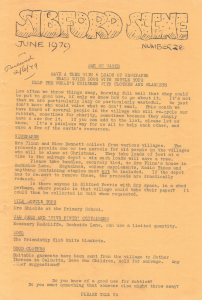A thousand children later
We congratulate Mrs Mary Poulton and Mr Jack Walpole who have both recently been presented with long-service awards by the Oxfordshire County Council after thirty years of teaching in the county. We asked them to give an account of their careers.
Mary Poulton
I began my teaching career in Sibford in 1936. The school was an Elementary School and catered for the education of children from 5 to 14 years. They were taught in three groups, Infants, Juniors and Seniors, roughly twenty in each group. I was in charge of the Juniors.
During the war we played host to a group of London evacuees. The older ones were integrated with our children, the younger ones being taught by their own teachers in the Friends Meeting House.
After leaving Sibford, I spent two short spells as Head of Swalcliffe and Mollington schools and then in late 1942 Justin and I married and spent eleven halcyon years at Now Barn Farm, raising our family – Diana, Rosalyn and Graham.
In 1953, a teacher who had been appointed to the Infant Department was unable, through ill-health, to take up the post, so I agreed to fill the gap for a month – a month which has extended to 25 years.
In 1966 I was persuaded by Mr Walpole to take a training course at Westminster College to become a Qualified Teacher, and I am eternally grateful to him for encouraging me to take this step.
I have quite lost count of how many children have come to me saying, “You taught my Mummy or Daddy” and although I threatened to retire when the first claimed that I had taught one of its Grandparents, it has happened – and now we have in the school Sean and Anita O’Keefe, grandchildren of Mr Ken Bishop, a member of my very first Junior class.
J. Walpole
After the last war, I began my teaching career in the County at Lawn Upton Junior School, at Littlemore. This was a large school with about 400 Juniors and big classes of 40 or so.
In February 1961, I applied for the headship of Sibford Gower Endowed School. So it was that after Easter our family came to live in the School House and I joined Mary Poulton and Barbara Skipper (now Crabtree) at the school. Straight away one could feel the friendly family atmosphere and good order left by my predecessor, Bob Penny.
I was exceedingly fortunate because I had missed all the disruption and difficulty during the work on the improvements that had just been completed. I was I working in modern conditions in a school founded in 1625. One of the previous Headmasters had been a Yeoman named Huntley, who evidently found education unprofitable and helped to found Huntley and Palmers Biscuit Factory at Reading.
I stayed at the village school for ten happy years and during that time there were very few changes of staff, but I am grateful to my past colleagues, Pam Perrett, Andrew and Sandra Rolls, Sheila Kinnish and, of course, Joan Shields who started to help out temporarily and is still in harness.
One of the features of life in the Village School during these years was the stream of visitors from all parts of this country – and indeed the world. I think it made a pleasant drive from Oxford!
I left Sibford to move to a bigger school, Harriers Ground, in Banbury. There I have tried to build up the same ethos that made Sibford School such a happy place.

